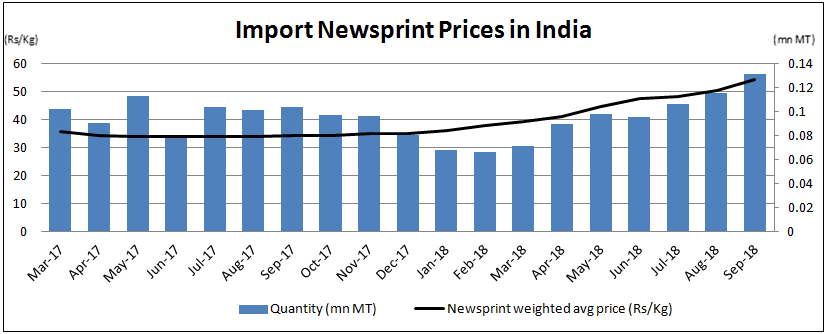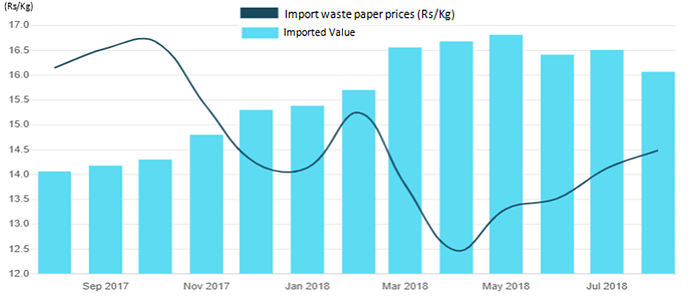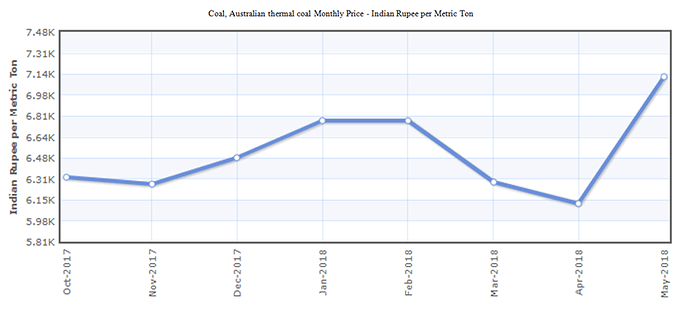Indian Paper Industry
In 2016, the world paper production stood at ~410 million MT, with India accounting for 4%, China for almost 1/4th production of 108.5 million MT, followed by long-term rivals of the US (71.8 million MT) and Japan (26.1 million MT).
The Indian Paper Industry provides direct employment to 5 lakh people and indirectly to around 15 lakh people. There are about 750 - 800 paper mills (organized & unorganized) in the country with an installed capacity of 14 million MT whereas the domestic demand for all varieties of paper is estimated to be around 17 million MT in FY17. The Import duty on paper & paper board for ASEAN countries has been reduced from 2.50% to 0% with effect from 1st January, 2014 which made cheaper imports possible in India.
Newsprint Industry in India
In India, newsprints are traditionally manufactured from waste paper where no pulp or agri residues are used. The newsprint segment comprises of ~15% of the Indian paper industry and has grown at a CAGR of 3.5% during FY08-17 to 2.6 million MT, on the back of improving literacy and increasing circulation of vernacular dailies. The prospect of newsprint segment primarily depends on its consumption by print media industry. However, imports account for a substantial portion of the consumption. The share of imported newsprint in the total domestic newsprint consumption increased sharply from 50% in FY13 to approximately 60% in FY17.
There are about 121 units manufacturing newsprints with an installed capacity of 2.6 million MT in our country, whereas the demand of newsprints was estimated at around 2.74 million MT in F.Y. 2017-18 (production 1.06 Million MT – Imports 1.68 Million MT). The broad characteristics of the industry are that it is, capital, energy and water intensive and highly fragmented (small units account for nearly 60% of the industry size). Newsprint paper is not subject to any import duty which remains a threat to domestic industry. However, it is subject to 5% GST which has helped to create a level playing field between the unorganized and the organized players.
For decades, China was the largest importer of waste paper but that’s changing after Beijing banned 4 classes or 24 types of scraps from entering its border starting in January, 2018 which includes all plastic scraps, unsorted waste paper, certain metal recycling residues, textiles and all unsorted waste or scrap. USA, EU, UK and Japan were amongst those that exported majority of their waste paper to China.
China started importing waste in the 1980s to fuel a growing manufacturing sector. It grew a whole waste processing and recycling industry, but improper handling of trash and lack of effective supervision turned the country into a major polluter. China led the world in 2016 by importing about 28.5 million MT of scrap paper. However, this number is expected to drastically go down in 2018 and be reduced to 0 by 2021 by enacting a complete ban of waste paper.
Waste paper is one of the major sources of raw material used for manufacturing newsprints in India. With the Chinese government’s decision to ban the waste paper imports has caused a drop in global waste paper prices. This led to a surge in the global pulp prices and reduced cost advantage of companies exporting paper to India. As a result, the price of newsprints in China has also increased due to short supply of waste paper. Indian manufacturers using waste paper stand to benefit on account of lower global waste paper prices (on excess supply) and higher realization for newsprints.
Recent Price Trends
Key Industry Highlights
• Newsprint paper prices see 40% hike
Newsprint is a low cost paper and is most commonly used to print newspaper, publications and advertising material. Newsprint paper has seen almost 40% spike in prices from the time China banned waste paper imports into the country at the start of the year. Newsprint paper, most of it imported into India, used to trade at Rs. 34/Kg at the end of 2017, rose to Rs. 45/Kg at the end of Q1 FY19 and is currently being sold at Rs. 52/Kg.
Most large Indian newspapers use a mix of domestic and imported newsprint. Typically, while English dailies use an 80:20 mix in favor of imported newsprint, regional language dailies employs the same ratio in favor of Indian newsprint.
Since more than 60% of the newsprint paper is being imported into the country, prices of newsprint paper are governed by international players. Before the price hike in newsprint paper in 2018, domestic manufacturers were forced to sell newsprint at par or below the import prices where their cost of production was similar to the selling prices essentially leaving no room for profits. Now when the prices have risen to Rs. 52/Kg none of the newsprint manufacturer want to sell below Rs. 1 – 2 from the imported newsprint prices.
Net of all, companies manufacturing newsprint paper from waste paper are expected to earn Rs. 10 – 20 EBITDA per Kg of newsprint sold going forward.
• Cost of production remains subdued
The commodity waste paper whose prices have stabilized to around Rs. 15/Kg, accounts for almost 55 - 65% of the total cost of producing a newspaper in FY18. Waste paper had seen a low of Rs. 12.5/Kg in March, 2018 on account of its abundant availability internationally due to ban of import of waste paper in China. In India, the recovery rate for waste paper remains low at ~30% due to lack of effective collection mechanism so the big players depend on the imports to meet their raw material requirements. A company needs around 1.25 Kg of waste paper to make 1 Kg of newsprint paper. Whereas, there are other materials such as chemicals and packaging materials which contribute around 5 – 10% of the cost of production.
Power and fuel costs which were lower on account of subdued coal prices have also increased in the recent past. Companies that were importing pet coke to make newsprints are switching to coal based production due to recent ban of pet coke in India. Also there is a restricted supply of coal domestically and in FY18 coal prices have increased which is expected to increase the cost of power.
Company to look out
•Shree Rama Newsprint Ltd.
Rama Newsprint Ltd. (RNL), incorporated in 1994 is the largest private sector player in the Indian newsprint sector today, with an annual manufacturing capacity of 1,32,000 MT of newsprint/writing and printing paper. RNL uses recycled paper as input material for producing newsprint and in FY18 company changed its product mix from writing & printing paper to newsprint paper completely. RNL has also taken packaged water bottling plant of 32,000 bottles per hour and orders were placed on 27th November, 2017 with Sure Technologies FZC Sharjah UAE.
RNL is promoted by Riddhi Siddhi Gluco Biols Limited with a holding of 59.85% as on September 2018. However, on 16th October 2018, Riddhi Siddhi Gluco Biols Limited took over additional 4.99% shares thereby accounting to 64.85% shareholding.
IN Q2 FY19, RNL reported a topline of Rs.155.99 crores with an EBITDA of Rs.27.45 crores and a PAT of Rs. 15.81 crores with a debt outstanding of Rs. 278.80 crores.
• Rama Paper Mills Ltd
Rama Paper Mills Ltd. (RPML) is engaged in the manufacturing of newsprint, duplex board and writing & printing paper by recycling waste paper with an installed fungible capacity of 61,000 MT. RPML’s manufacturing plant is located in Bijnor, UP and is promoted by Promod Agarwal with promotor holding of 20.56%.
RBI’s 12th February circular which scrapped all the past restructuring mechanism and gave companies 6 months to come up with a resolution plan following which financial creditors were supposed to move the NCLT made RPML do a One-time settlement (OTS) with Bank of Baroda and IDBI bank. An OTS with Bank of Baroda in an aggregate amount of Rs. 36.05 crores plus interest at 12% till the date of payment was done whereas an OTS with IDBI bank of Rs. 5.00 crores was done in full and final settlement against the debt of the company. For OTS, RPML has availed financial assistance from Shapoorji Pallonji Finance Private Limited to the tune of Rs. 31 crores at ~ 17 – 18% interest. Promod Agarwal have also pumped in additional ~ Rs. 20 crores into the company at no interest for the working capital requirements.
IN Q1 FY19, RPML reported a topline of Rs.60.85 crores with an EBITDA of Rs.26.34 crores and a PAT of Rs. 25.52 crores with a debt outstanding of Rs. 15.4 crores. The topline includes other income of Rs. 19.84 crores which is write back of unpaid principal being gained by the company because of one time settlement.
Disclosure : Invested






